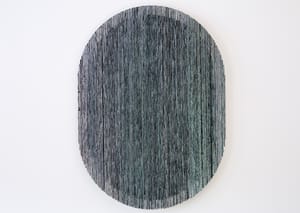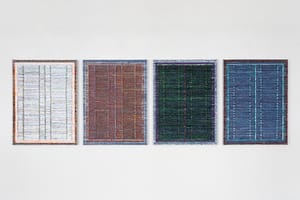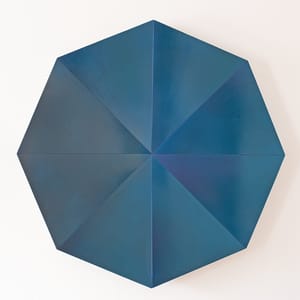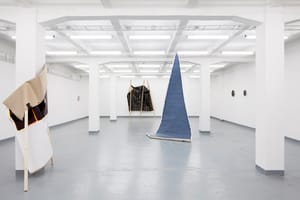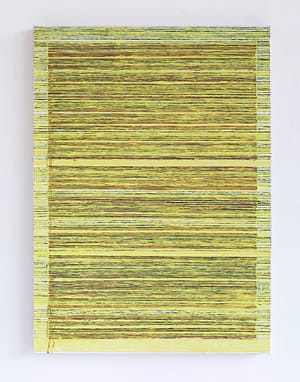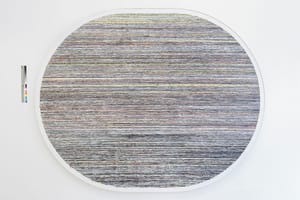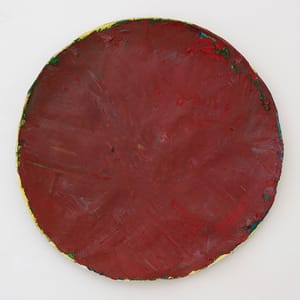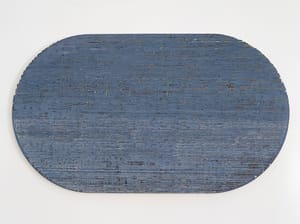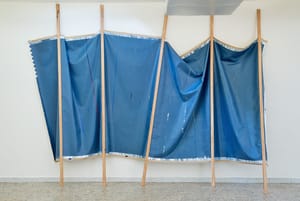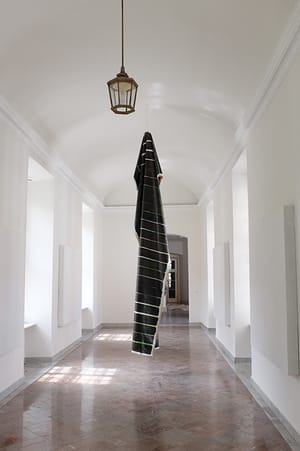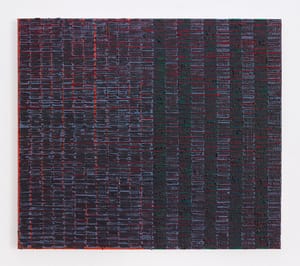- First Name
- Břetislav
- Surname
- Malý
- Born
- 1985
- Birth place
- Hradec Králové
- Place of work
- Brno, Polešovice
- Website
- www.bretislavmaly.com
- Keywords
- CSU Library
- ↳ Find in the catalogue
About artist
A feeling of responsibility to tradition often impedes artists when deciding how to treat painting and its fundamental and secondary components. It was only modernist self-confidence that began to accentuate autonomy, and this evolved into an era of reductive painterly abstract approaches that eliminated the contextual overlaps in favour of a romanticising spirituality. Painterly autonomy was given additional support during the era of the (post)conceptual interrogation of the determinants of the visual itself.
A cursory look at the paintings of Břetislav Malý would lead many viewers to conclude that they are dealing with one of the many methods of abstract painting that stand on the boundary of lyrical and structural abstraction and a painterly style thematising minimalist starting points spiced up with optical illusion. None of this is true. What Břetislav Malý is concerned with is above all an investigation into painting itself, or rather its most important component, i.e. colour, the way it is processed, variants of its layering and application, and its mutual interaction within the framework of each colour itself and their layered relationships. Břetislav Malý considers painting without having to resort to verbal interpretation. In other words, he interrogates colour by means of colour without having to articulate this interrogation in words.
This tautological way of thinking about the chosen subject matter forms one of the important strands in the philosophy of language. It should therefore not surprise us to discover how often Malý refers to the work of Ludwig Wittgenstein, who in his Remarks on Colour regards colours as phenomena related to speech. Wittgenstein looks at how we think about colours when we speak of them, and how this speech is significant in respect of how we in turn perceive them. The problematisation of the (non)loss-making semantic and contentual transfer between the medium of the painting on the one hand, and the world of the text or speech on the other, is once more explored in the work of Malý, but differently than it was in the era of conceptual research in the sphere of analytical philosophy. This new approach enables him to cut in two the seemingly inseparable, and he releases the word and the image from their traditional dependence. In his paintings there is no repetition of a rational, analytic description of the utilisation and reflection of colour in speech or vice versa. Above all, he conducts research that does not need or demand an interpreting transformation into another semiotic system. His paintings seem to confirm the words of Wittgenstein himself: “That whereof we cannot speak, thereof we must remain silent.”
For this reason, the perception of his paintings does not require anything more than a receptive and contemplative eye, whose task is to investigate the surfaces of the canvas and “bury” the coloured residuals of the underlying surfaces or the way the individual layers are placed on each other. Or else to examine their impasto spread, the subtle transitions between the tones selected and the deconstruction of the orthogonal spread of the image. The artist’s painterly, analytical considerations are strictly delineated from the expectations associated with the traditional narratival and mimetic function of painting. On the other hand, the binding logocentric imbalance between word and image is eliminated and the image declaratively and logically situates itself in place of the word. That which colour is and remains in Malý’s paintings is above all its very facticity, to the point at which one might wish to emphasise that colour is colour is colour. Always the same and itself. And yet other every time, an other by virtue of the multiplying and transforming relationships and ephemeral links between the local and the dominant colour scheme, as well as between different methods of its tractation.
- Author of the annotation
- Martin Mikolášek
- Published
- 2019
CV
2006–2012 Fakulta výtvarných umění VUT v Brně (2006 - 07 u doc. Petra Veselého, od roku 2007 u doc Tomáše Lahody)
2011 VŠVU v Bratislavě u MgA. Klaudie Kosziby Phd.(odborná stáž) 2007 Akademie v Poznani u prof. zw. Włodzimierza Dudkowiaka (odborná stáž)
Exhibitions
- Solo exhibitions
-
2018
"Podívej se skrz a zase zpět ck again ", Galerie Petr Novotný, Praha
"Floating garden", České centrum, Miláno
"Tomas Rajlich, Břetislav Malý", Etcetera Gallery, Brno
"Snahy o lety na lyžích urputné malby zrcadlí obraz", Galerie města Trutnova
2017
"Re Vize", Galerie moderního umění v Roudnici nad Labem
"Neschopnost obrazu zobrazit realitu, Galerie Panský dvůry, Veselí nad Moravou "Butterfly Effect", Galerie 2 + 1, Bechyně
"Úplný prostor žluté barvy", Galerie Aspekt, Brno
"Angry sequences of yellow color", Galerie 101, Praha
"Ludwig vypustil draka", White pearl Gallery, Praha
2016
"O červené", Galerie města Blansko
"1, 2, 3, .....", Galerie 209, Brno
2015
"Barva místa", Richard Adam Gallery – Galerie na mostě, Brno
"Zánik prostoru, jako následek barevné syntézy", GM, Brno 2014
"Noc čeká", Galerie Dole, Ostrava
"Uklizeno", Avoid Gallery, Náplavka, Praha
"Odlesk", Galerie Jiřího Putny, Brno
"V potoce mléčnou dráhu viděti", Galerie Měsíc ve dne v Českých Budějovicích
2013
"Muž v počasí", Galerie Vladimíra Hrocha v Uherském Hradišti
"Noví bozi (bůh je mrtev a my jsme ho zabili)", Galerie Doma v Kyjově
2011
"Okna", Galerie Půda, Jihlava 2010
"Focus show", Galerie Platínium v Brně, Brno
- Group exhibitions not included in ARTLIST.
-
2019
"Za obzor" Zámek Mikulov, Mikulov Castle
"Mladí a svěží" Galerie Města Trutnova, Trutnov
"Plnost redukce", Etcetera Gallery, Brno
2018
"Mladí a svěží" Galerie 101, Praha
"Mladí a svěží" Galerie města Plzně
2017
"Ripple Effect", Centrum pro současné umění, Praha
"Art prize CMB", CRAG GALLERY – CHIONO REISOVA ART GALLERY, Turin, Italy
2016
"Uhlem, štětcem, skalpelem",Muzeum moderního umění Olomouc
"Strom II.", Galerie Slováckého muzea, Uherské Hradiště
2015
"Tváře krajiny", Rabasova Galerie, Rakovník
2014
"Včelou a mlíkem", Galerie Jiří Putna, Brno
"Mladé setkání", Galerie Hodonín
2013
"Fail industry", Galerie Horní konírna v Mikulově
"Lepší barva", Dům u divokého muže, Mikulov
"APARTMENT PRIVATE ART PARTY IV", Vila Střelák, Brno
2012
"Salve Europa Fine Art Challenge", "Na přechodu", diplomanti FaVU, Muzeum města Polička
"Diplomky", The Chemitry gallery, Praha
"Diplomanti FaVU", Dům pánů z Kunštátu, Brno
"Milý malíři, namaluj mi...", Wanieck gallery, Galerie za stěnou
"The way around", Cooltour centrum současného umění v Ostravě
2011
"Co jsem Dělal o Prázdninách", Galeri Ars, Brno
"Echt Gold Sýpce", v Galerii Sýpka, Vlkov u Tišnova
2010
"Sweet", Galerie Alternativa OGV v Jihlavě
"Art Safari", Ateliér Čestmíra Sušky, Řeporyje, Praha
"Focus show", Břetislav Malý, Vojtěch Horálek, Galerie Dolmen v Praze
2009
"Český Tučňák", souutěžní festival mladého umění- Praha
2008
"V Praze je blaze", Galerie kritiků, Praha
"13 x FAVU", Výstavní síň Synagoga v Hranicích na Moravě
- Collections
-
Galerie Moderního umění v Roudnici nad Labem
Muzeum umění Olomouc
Richard Adam Gallery (Wannieck gallery)
Fait Gallery
Galerie výtvarného umění v Hodoníně
Monography
- Monography
DOSTÁL, Martin. Mladí a svěží: zaručený průvodce nejmladší malířskou generacací (pro současné i budoucí sběratele i sběratelky) = Young and lush : a guaranteed guide to the youngest generation of painters (for current and future collectors) : Filip Dvořák (1990), David Krňanský (1987), Martin Lukáč (1989), Břetislav Malý (1985), Tomáš Predka (1986), Julius Reichel (1981), Sofie Švejdová (1990), Namor Ynrobyv (1988). Přeložil Stuart HOSKINS. Praha: KANT, 2018. ISBN 978-80-7437-255-1.
MAZÁČOVÁ, Petra. Re Vize. 1. Ústí nad Labem: Galerie moderního umění v Roudnici nad Labem, 2017. ISBN 978-80-87512-66-1
MALÝ, Břetislav, Martin DOSTÁL a Zuzana JANEČKOVÁ. Břetislav Malý 2. Přeložil Alžběta POLIŠENSKÁ. Praha: KANT - Karel Kerlický, 2017. ISBN 978-80-7437-227-8.
Mikulovské výtvarné sympozium: dílna .. Mikulov: Městský úřad, 1994. ISBN 978-80-7437-210-0
BINDER, Ivo, Ladislav DANĚK, Martina MILÁČKOVÁ, Anežka ŠIMKOVÁ a Pavel ZATLOUKAL. Uhlem, štětcem, skalpelem.. Muzeum Umění Olomouc: Muzeum Umění Olomouc, 2016. ISBN 978-80-88103-04-2.
Strom. Uherské Hradiště: Slovácké muzeum v Uherském Hradišti, 2016. ISBN 978-80-87671-27-6
VESELÝ, Petr a Richard DRURY. Tváře Krajiny. 300. Rakovník: Rabasova Galerie, 2015.
MIKOLÁŠEK, Martin. GALERIE DOLE. Galerie Dole 2014. Ostrava: O.S. Fiducia, 2014. ISBN isbn 978-80-906016-0-4.
ZÁLEŠÁK, Jan. Light Factory. Brno: Vlastní náklad, 2013
HOUSER, Milan a Jan ZÁLEŠÁK. Diplomanti FaVU 2012: [výstava praktických diplomových prací absolventů Fakulty výtvarných umění VUT v Brně : 13.6.-28.6.2012 Wannieck Gallery : 30.6.-26.7.2012 Dům pánů z Kunštátu. V Brně: Fakulta výtvarných umění VUT, c2012, 99 s. ISBN 978-80-214-4531-4.
TUČKOVÁ, Kateřina. Arskontakt 09. Brno, 2009.
15 let FaVU VUT v Brně: Vysoké učení technické v Brně, Fakulta výtvarných umění. Redaktor Petr Spielmann, Filip Komárek, Andrea Štekrová. V Brně: Vutium, 2008, 232 s. ISBN 9788021436336.
TUČKOVÁ, Kateřina. Arskontakt 09. Brno, 2008. Katalog k soutěžní výstavě
"Figurama 08", 2008
- Articles
Lipavský, Matěj. Nitkový vodopád na nic nedopadá. Souvislosti, 2014, 25(3), s. 104-106. ISSN 0862-6928.
Lipavský, Matěj. Nika. Souvislosti, 2012, 2, s. 73-77. ISSN 0862-6928.
"Ateliér - Matěj Lipavský". Revolver Revue: Kulturní magazín. Praha: Sdružení na podporu vydávání časopisů, 2016. č. 103. ISSN 1210-2881.
"Práce venku je pro mě nezastupitelná" - rozhovor s M. Lipavským. Revolver Revue: Kulturní magazín. Praha: Sdružení na podporu vydávání časopisů, 2014. č. 97. ISSN 1210-2881.
Revolver Revue: Kulturní magazín. Praha: Sdružení na podporu vydávání časopisů, 1987- . ISSN 1210-2881.


